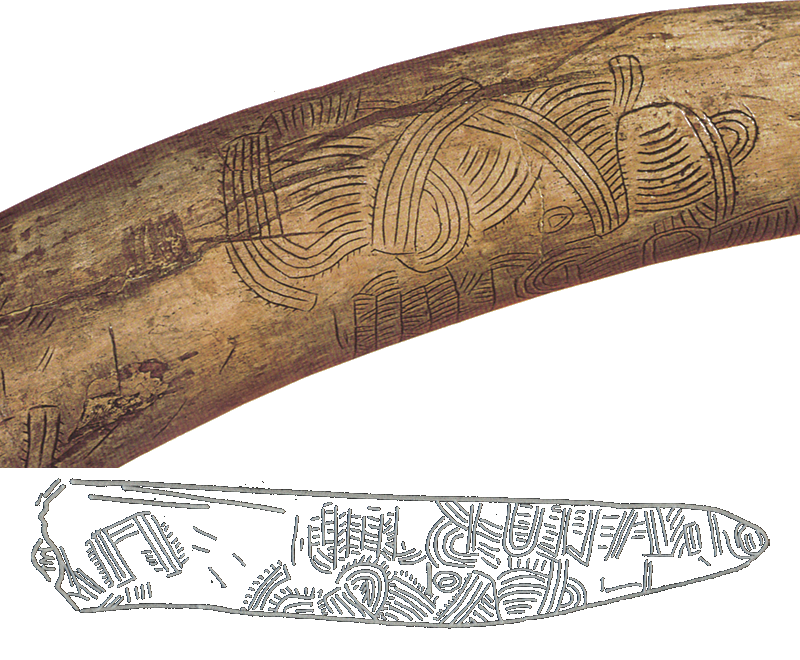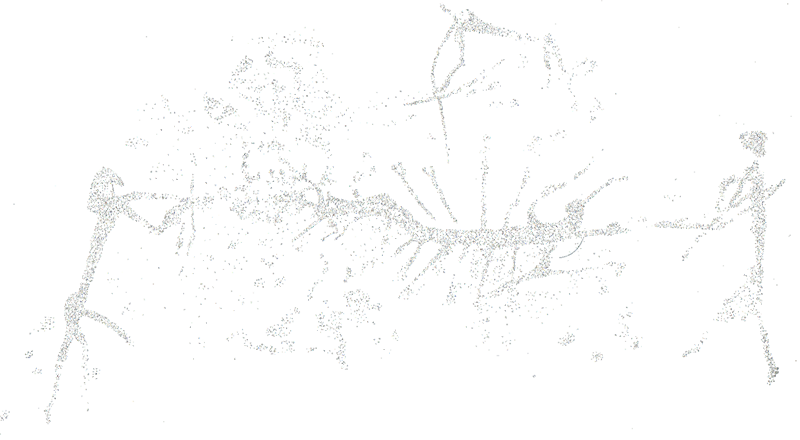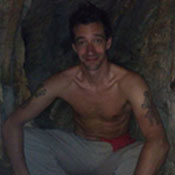In his Manifesto of Visionary Art, artist and author Laurence Caruana elucidates a near-exhaustive list of the sources and inspirations from which Visionary Art can spring. It is worth quoting:
“...the sources of Visionary Experience are many and varied: dreams, lucid dreams, nightmares, hypnogogic images, waking dreams, trance states... hypnotic states, illness, near-death experiences, shamanic vision-quests, meditation... madness... day-dreaming, fantasy, the imagination, inspiration, visitation, revelation, spontaneous visions, psychedelics, reading and... the metanoic experiences brought on by Visionary Art itself.”
The debilitating headache and motion sickness sensations of migraine are relatively well-known, but perhaps less famous is the sudden and jarring photophobia and bodily disorientation strong enough to require rest and recuperation. For the one in five of us who experience the migraine with aura, however, the experience can be much stranger.
These flashing forms are often of a brightness and intensity to physically hurt (and in the fullness of time, the head and the body follow) and a strange kind of blindness emerges in which the outer world is seen but drowned out by the intensity and physical shock of the flickering lights. They are often monochrome, or better still, a sickeningly intense white, as if staring into the sun, but occasionally, under cover of darkness, they take on colours. When they do, the flashing often shifts rapidly between primary colours, in which reds, greens and blues blur into white flashes before separating again and increasing the sense of visual disorientation. Another daylight feature is to see bright red and blue sheets of flickering bands while shadows and dark spaces in my field of view turn bright purple. It is as if the two-dimensional sheet of everyday reality is being shredded to reveal the raw sensations of colour that lay behind.
On the neurological level, however, something remarkable is occurring. For reasons not yet clearly understood, an electric wave has begun a slow progress of movement (at around 0.5cm per minute) across the folds of the brain's visual cortex, causing blood vessels to constrict and neurons to fire in unusual patterns. This wave may be involved in generating the headaches and dysphoria, particularly the stress the brain undergoes in seeking to manage and interpret this intra-neural oddity, but as it strikes a particular node or surface of the cortex, information is passed down the optic nerve from the visual cortex to the retina, reversing the customary flow of information as it were; this information is also passed to other modules of the brain as live, external data.
The language I’m using here is deliberately careful: these are no more visions of light than they are nightmares of darkness. They are fractured, distorted images only half-formed – some are bright, some deathly, while others are surreal or visually so odd as to be barely perceptible. They are not quite archetypes, not quite images, but shards and slices of images often lacking in dimensionality or coherence. Running legs burst out from the portal hole before disappearing; half an animal flickers on the boundary, causing it to expand momentarily before resuming its circular shape. Moments of visual clarity give way to twisting and flashing confusion and moving, watery figures emerge fully from the light before melting away in a shower of flickering shards.
This is not an easy experience to behold. A key theme here is an overwhelming synaesthesia: the images physically hurt, or have enfolded into their very being a volume of jagged sound that renders the migraineur with a profound sense of unease even when beholding an image of light. External sounds generate unpleasant images – even being touched by one's partner in reassurance can intensify the flashing or cause an awful buzzing to be released.
It wasn't until my early twenties that I discovered that many of these experiences were visually represented in prehistoric art from around the world, and constituted in particular a prominent feature in the Southern African rock art traditions from around 25,000 years ago to the present day. The first time I explored books of San Bushman rock art, I became transfixed by the navicular forms (so called as they were originally considered to have represented ocean-going vessels), becoming excited at having seen some of them directly, and even being momentarily transported back to dysphoric sensations that some of them had accompanied.
My skin feels electric and moves stingingly with even the tiniest sound: ripples of sonically-expressed energy move in disordered ways over and through me, rendering the experience of my body as somehow intact yet simultaneously torn-apart, leaving my consciousness floating in a strange void which is very difficult to describe. Simultaneously, there is unbearable smoothness all around me, perhaps a reaction to the jagged electricity, and a sense that I am somehow climbing, as though moving or being dragged uphill on a difficult terrain accompanied by constant buzzing and shards of tactile body-lightning. Many years ago, I coined the phrase: Upon Lightning Mountain.
(Digital Remix 2014)
...Climbing, forever climbing, until I reached the edge of the smoothness which folded away downwards out of sight, there to find my mother screaming my name at deafening volume. I could not see her, but her voice had a physical form of intense power, each word screeching lightning shards out to every part of my inner cosmos. My whole body shuddered as if electrified, and then shattered...
...I was in two places at once, lying in my bed vomiting, and simultaneously throwing myself from the hallway balcony to crash, very neatly, head first, onto the stairs below, breaking my neck. In my delirium I was wailing “I should be out there, killing myself on the stairs”, words sure to strike terror into the parents of any eight-year-old child...
...returning home from a visit to Manchester, a migraine struck and the only way to wellness was to retrace my journey by spelling out backwards all the names of the places I had passed through to get home. The letters were written on sickeningly smooth paper... R..E..T..S..E..H..C..N..A..M, and so on, an arduous task I was close to completing until I entered a deep tunnel and found the letters for the town of Gloucester. I couldn't recite these letters backwards without vomiting heavily. Almost a sense of relief, except that when I retreated back into the bed, I was back in Manchester, facing the whole task again...
Such weirdness is ubiquitous on Lightning Mountain. Not quite nightmares, neither visions nor dreams, their synaesthetic strangeness has only been matched by my experiences with the Mazatec entheogen salvia divinorum: the flickering lights at the onset of a salvic voyage share parallels with the miraineur's aura and while the electric surreality is similar, salvia images are ever-moving and holistic, lacking any sense of fractured imprisonment.
One thinks through mud, as if parts of the software of the brain have not yet come back online. Making choices, even simple ones, is difficult, partly because I often fail for a moment to understand what is happening: that I have to make a decision. Long sentences fragment in one's ear, complex thoughts dissipate. The head feels heavy, as if it has somehow become a beautiful crystal skull, once pristine, but now there are cracks deep within. The mind is subtly different, and feels as if some kind of neurological re-wiring has occurred. Who knows, it probably has...
“At least part of the... prevalence of migraine might... be explained by interaction between the modern environment and a human nervous system that evolved in times of less sensory overload. Modern life is characterized by much more frequent exposure to many of the known triggers of migraine attacks than was the case during much of human existence... [including] bright light, loud noise, chronobiological challenges, altered sleep/wake patterns and emotional stress. We no longer live in caveman days, but given the immense periods of time required for evolution to act, correction of this mismatch between the human nervous system and the modern environment will necessarily lag behind the pace of environmental change by thousands or even millions of years.”
Both of these ideas point to an interesting possibility, that the nervous system of the migraineur is, perhaps, a little more archaically-oriented than the average human. A decreased habituative mentality would certainly be an advantage for spotting danger in nomadic hunter-gatherer situations, and a lower ability to cope with modern sensory inputs suggests a temperament primed for the kind of undistracted isolation that hunter-gatherer societies tend to enjoy.
And it is in the art of hunter-gatherer societies, from the Upper Palaeolithic to the modern day, where we see the clearest expressions of migraine-related imagery. I first recognised the relevant image-forms in San Bushman rock art, but European cave art also contains some powerful resonances with these experiences – indeed several of the tectiform structures from the previous essay on the art at El Castillo have an authentically migrainesque flavour – and it is with a selection of these primarily entoptically-inspired images that we here close.
Jill Cook, Ice Age Art: Arrival of the Modern Mind, British Museum Press, 2013
David W. Dodick & J. Jay Gargus, Why Migraines Strike: Biologists are finally unravelling the medical mysteries of migraine, from aura to pain, Scientific American, August 2008, url: http://www.scientificamerican.com/article.cfm?id=why-migraines-strike , retrieved March 2010
David Lewis-WIlliams, Reality and Non-Reality in San Rock Art, Raymond Dart Lectures,1988
David Lewis-WIlliams, The Mind In The Cave, Thames & Hudson, 2002
E. Loder, What Is The Evolutionary Advantage Of Migraine?, Cephalalgia Review, 2002, url: http://cep.sagepub.com/cgi/content/full/23/9/931 , retrieved June 2010
Elspeth Parry, Legacy On The Rocks: The Prehistoric Hunter-Gatherers of the Matopo Hills, Zimbabwe, Oxbow Books, 2000















 RSS Feed
RSS Feed






